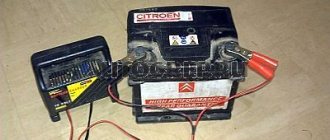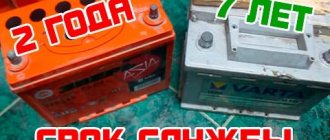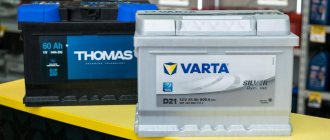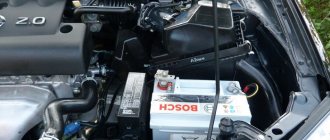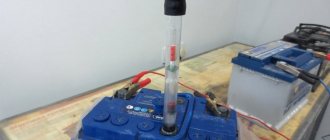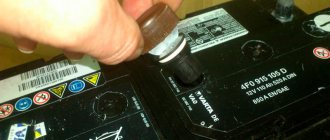Many motorists are familiar with the problem of rapid battery discharge even in the absence of a high load.
There are very severe cases - a battery charged 50% today becomes completely discharged tomorrow and this is discovered when trying to start the engine. A motorist charges the battery to 100%, but tomorrow it is half discharged again. How to solve this problem? Buying a new battery is not cheap, but replacement is not objectively required in every case; sometimes checking the density and topping up the electrolyte is enough.
Many car owners are concerned about the advisability of adding electrolyte to a battery if its density is insufficient. Perhaps it would be better to make a replacement? Let's consider different situations to find out how best to act in a given case.
Complete replacement of electrolyte in the battery
The electrolyte is a mixture of sulfuric acid and water in a certain proportion. The concentration of a solution is determined by the density measured by a hydrometer. The basic indicator, even hundredths, affects the ability of the electrolyte to work to store energy.
Signs of an unusable electrolyte:
- Measuring density on a charged battery with a hydrometer. The value should be 1.25 -1.27 g/cm3.
- A cloudy electrolyte is evidence that parasitic sulfation processes are taking place inside.
- The electrolyte froze, but the seal of the case was not broken.
- The solution is black or dark brown with a suspension of coal and scale.
Replacing the electrolyte in a battery will be effective when the cavities of the cans are examined, washed, and sulfate deposits are removed. If the plates are destroyed and the active substance has fallen off, the battery cannot be repaired.
At home, a complete replacement of the electrolyte in a car battery occurs in the following sequence:
- Prepare enamel or glass containers for draining the electrolyte, personal protective equipment, and a place to work, preferably outdoors.
- Remove the battery from the car, remove the plugs or drill holes in the maintenance-free battery, drain the liquid into a prepared container using a bulb or syringe.
- The battery is washed with distilled water several times until the sediment is removed. Lead sulfate may need to be removed if there is residue on the plates. You need to make sure that the active putty has not crumbled and that the coal grate is intact.
- Slowly, intermittently, pour the electrolyte of the required density into each jar 5-7 mm above the plates. Wait 2-3 hours for the bubbles to come out, measure the density of the electrolyte, bring it to normal
- After replacing the electrolyte, charge the battery with a low current of 0.1 A, avoiding boiling. After reaching half the capacity, charging is carried out cyclically.
- Seal the cans.
How long does it take to charge the battery? After replacing the electrolyte, you need to charge the battery carefully, as after a deep discharge. The operation of replacing the electrolyte with your own hands in a car battery is considered complete if it fully accepts current for a long time. Charging is carried out carefully; boiling in jars is unacceptable.
We invite you to watch a video on how to properly replace the electrolyte in a car battery.
This is interesting: Is it possible to use fog lights as daytime running lights?
What kind of fluid is in the battery?
Before talking about the liquid that is in the battery, let us clarify that this article is about serviceable batteries. If the battery has a different design and the manufacturer does not provide the ability to control the level and top up fluids in the battery, then this is not possible.
Of course, if necessary, you can convert a maintenance-free battery into a serviceable one. But in this case, you need to understand that you can cause irreparable harm to the battery, after which all that remains is to dispose of it.
You also need to understand that a special gel can be used as an electrolyte. These are so-called gel batteries. The manufacturer of such batteries also does not provide for adding fluid.
Thus, let us determine that in our case we are talking only about serviceable batteries. They use a solution of sulfuric acid and water as an electrolyte. This ratio is 3:7 (30% sulfuric acid to 70% distilled water).
You can learn more about the processes occurring in the battery, the composition of the electrolyte and methods of its preparation by reading the article “what acid is poured into the battery.”
When is adding electrolyte to the battery more appropriate than replacing the battery?
The electrolyte components of any battery are acid and distilled water. These liquids form a mixture in which water predominates, while acids are much less. For example, you need an electrolyte whose density should be 1.28 g/cu. cm. In this case, 0.36 liters of acid must be poured into 1 liter of distilled water. The proportion will be approximately 1:3.
For safety, it is necessary to pour acid into water, but in no case the other way around! Otherwise there is a high risk of a chemical reaction resulting in heat and splashing. Contact of battery acid with the skin will cause severe burns. The reason for this is the lower density of water compared to acid, as a result of which these liquids mix extremely slowly.
The volumetric proportion of water and acid is determined using a hydrometer. This device determines the density of a liquid. After reducing the density of the electrolyte to a certain value, it does not retain the charge well enough. If the density is slightly below the required 1.3 g/cc, electrolyte should be added.
The change in electrolyte density depends on the battery charge. For this reason, the exact density of the battery fluid is only possible when the battery is 100% charged. You can read how to properly charge the battery in a separate article.
%rtb-4%
How to determine the required quantity for a battery?
You can understand how much is needed to replenish the mixture with electrolyte (provided that this is what is needed) or distilled water (in a similar case) in the following ways.
Visually
The manufacturer applies special “risks” min – max to the battery case. It is by the marks on the battery that you can navigate how much is required (and what exactly) to add to the mixture. When filling, you must ensure that the required amount is added above the minimum mark, but below the maximum.
If there are no marks on the body, then you need to add so that the metal plates are covered by 1-1.5 cm.
Instrumentally
There are special measuring tubes with which you can measure the level of the electrolytic mixture.
If you don’t have a device, you can use any glass or plastic rod. A stick 20-25 cm long and 5-7 mm thick is suitable.
Having opened all the cans, you need to measure the level in each one individually. To do this, lower the tube all the way and lift it up. It will clearly show how much mixture is in the battery jar.
You need to add until the level reaches a height of 1.5-2.0 cm. If distilled water is added to the required level, the density of the electrolytic mixture will be restored to its original parameters of 1.27 g/cm3. This is necessary to ensure full operation of the battery.
Attention! Topping up maintenance-free batteries is not provided by the manufacturer! Access to the banks is strictly limited by the complete sealing of the housing.
The video provides detailed information on how to measure the electrolyte level in a battery:
What needs to be added
Among novice car enthusiasts, you can often hear that only electrolyte or even hydrochloric acid needs to be added to the battery. Let us examine these erroneous judgments in more detail. Let us immediately note that only electrolyte based on sulfuric acid can be poured into the battery.
Sulfuric acid is involved in the reduction and oxidation reactions that occur between the battery plates. Thanks to this interaction, an electromotive force appears. Hydrochloric acid based electrolyte is not suitable for such reactions.
To answer the question of what should be poured into the battery - electrolyte or distilled water, it is necessary to consider another question: what will evaporate first? The sulfuric acid itself does not evaporate in the electrolyte, since it is a non-volatile liquid - water evaporates.
When the engine starts, the battery produces an electric current, the strength of which can be several hundred amperes. During chemical reactions, water evaporates, which is part of the electrolyte. Also, water can evaporate when the battery is charging.
In addition, intense evaporation of water can occur if the relay regulator on the car is faulty. In this case, once the battery is fully charged, there is no charge voltage limitation, which causes increased water evaporation.
The density of the electrolyte depends on the ratio of water and sulfuric acid. As the density increases, damage to the plates and precipitation of salts may occur. Therefore, to achieve the required density, it is necessary to fill only water and not electrolyte.
But if the electrolyte density is insufficient and at very low temperatures, it can freeze and the battery will fail. Therefore, when operating a serviced battery, it is very important to monitor both the density and the electrolyte level. For a maintenance-free battery there is no such problem, since the battery is sealed and all evaporated water returns to the battery compartments.
But if you pour water from a tap, you can harm the battery. Ordinary water is not suitable for topping up, as it contains a large amount of mineral salts and various organic compounds. Therefore, distilled water should be used to top up the battery.
If there is not enough water
If the liquid in the battery compartment is below the required level, you need to measure the density of the electrolyte and add distilled water to the required level, not forgetting to control the density.
If there is no water at all
Some batteries are sold without electrolyte. This does not mean that the seller deceived the buyer and provided a low-quality product. Such batteries are called dry-charged and are sold without electrolyte. The electrolyte is usually supplied in the form of 6 bottles, connected to each other in such a way that their necks coincide with the filler holes in the battery. So, filling of electrolyte occurs conveniently, simultaneously into all jars.
During production, batteries undergo a forming process that includes charging the battery, washing it and drying it with a stream of hot air. To protect the lead plates from damage, the filler necks of the cans must be hermetically sealed with special tape or stoppers.
This battery can be stored for up to 5 years. It is not allowed to store a battery with electrolyte for more than 6 months.
Filling electrolyte in a dry-charged battery
When purchasing a battery complete with a container full of electrolyte, the procedure will be as follows:
- Work must be carried out in a special ventilated room with an air temperature of at least +20°C, using protective equipment.
- It is necessary to open a special venting hole on the battery.
- Remove the protective tape and plugs from the filler necks.
- Prepare a container containing electrolyte by first unpacking and opening it.
- Turning the battery over, insert the containers with electrolyte into the holes of the battery filler necks.
- Carefully turn the battery and container over, avoiding spillage of liquid.
- After filling the jars with electrolyte, remove the empty container.
- To completely soak and cool, you need to leave the battery for about 20 minutes.
- You need to check the electrolyte level and top up if necessary.
- During the period, no earlier than 20 minutes and no later than 2 hours after filling the electrolyte, its density is checked. It should be within 1.25 g/cm3. If the density is lower or the voltage is less than 12.5 V, then the battery must be charged.
- After preparing the battery for operation, the venting hole and the filler holes are closed.
If the electrolyte has evaporated due to improper use or storage of the battery, most likely the battery will have to be disposed of. But there are still some chances to restore the functionality of such a battery. The sooner you notice this, the greater the chance of returning such a battery to service.
Important! If you have no experience in servicing batteries, it is better to entrust this procedure to specialists. Otherwise, it may be damaged or injured.
We will proceed from the fact that the battery was in a fully charged state before it dried out. In order to restore its functionality, the battery must be discharged. To do this, fill all jars with distilled water. After filling the cans and impregnating the plates, you can begin discharging the battery. We connect the load, preferably of low power.
After the battery is discharged, you need to charge it. We do not pour out the water that was poured into the jars. We charge with low current. For example, if the charging current, which is recommended for a given type of battery, is 10% of its capacity, then the current in our case should be half of this current, that is, 5%.
When charging, you should check the density. If the process goes well, the latter should increase. The signal for the end of the charge will be the intense release of gases from the cans, the so-called “boiling” of the electrolyte. The density of the liquid should be 1.15-1.2 g/cm3. If continued charging is required, the current should be reduced.
Expert opinion
Alexey Bartosh
Specialist in repair and maintenance of electrical equipment and industrial electronics.
Ask a Question
If the liquid in the battery jars turns dark during charging, this means that the battery is damaged. In this case, there is no point in continuing the restoration process and the battery will have to be disposed of.
After reaching the required density, the liquid is drained. Instead, distilled water is poured in and the discharge-charge cycle is repeated. This process takes a long time, approximately 2 days or more. As a result of these actions, the density should not increase during charging.
Then, after all the liquid has been drained from the battery, we fill in the real electrolyte and discharge it again. To do this, we connect a small load. After a complete discharge, we charge with a low current.
When charging, pay attention to the contents of the cans and the density of the electrolyte. If the electrolyte has darkened and the jars show signs of plates falling off, then the battery will have to be disposed of. If the electrolyte is transparent, we continue charging until the density of the electrolyte in all banks is in the range from 1.25 to 1.27 g/cm3.
It is possible that the density of the electrolyte in the jars varies significantly. In order to level it, you need to repeat the charge-discharge several times. You need to discharge to 10.5 V.
What to do if there is no distilled water
The first thing that comes to mind is to buy a new bottle of distilled water at the store. But some car owners prefer to make distilled water themselves because they do not trust the quality of commercially available water.
After all, if low-quality water is poured into the battery, it will, of course, work for some time. But after a while, you may just have to throw it away. The minerals contained in this water will settle on the plates and lead to a short circuit. No one will make a claim to the seller of such a product, since a lot of time will pass and it will be impossible to prove anything.
The best way to protect yourself from low-quality goods is to purchase goods from a reputable manufacturer that guarantees the quality of its products. This can be done both in specialized stores and in online stores. Signs of quality will be customer reviews and the cost of the product.
You can get distilled water yourself at home using a distillation cube (moonshine still). In addition, you can purify water this way: pour it into a plastic bottle and keep it in the freezer for 2-3 hours. Only ice is suitable for use; any remaining water is discarded.
After preparing distilled water yourself and if you are not sure of the quality of the purchased water, you need to check its hardness level. The most correct way is to use a specialized device, a TDS meter. It can be purchased in the online store for a small price. Ideally, it should show 0 ppm; water with a reading of 10-20 ppm is allowed.
What does the battery consist of?
The battery in a car is responsible for starting the engine, the proper operation of all the car’s electrics, and also “smoothes out” voltage surges. Inside the housing, it consists of 6 series-connected elements consisting of positive and negative conductive plates. These elements are filled with electrolyte, interaction with which ensures the result of the work.
The liquid itself consists of distilled water and acid mixed in a certain proportion. The norms of proportions change depending on the required density of the mixture, and the norms of mixture density, in turn, depend on the temperature and climatic characteristics of the area where the car is used.
Preparatory work
Before servicing the battery, you should study the instructions, which fully describe how to properly add electrolyte to the battery, and it is also important to read the charging instructions .
In order to properly add electrolyte to the battery, it is important to prepare the workplace where this operation will take place.
Also, do not neglect safety precautions:
- The first thing you need to do is put on overalls, which includes a set of pants, a jacket, rubberized gloves and safety glasses.
- Place the battery on the workbench and clean it of various dirt using a rag. The main attention should be paid to the positive and negative contacts.
- Check the battery with a multimeter.
- Carefully open the covers using a Phillips screwdriver.
This is interesting: How many liters of oil are in a Peugeot 3008 engine
In what cases should electrolyte be added to the battery?
Electrolyte is added to the battery when the capacity decreases. At the same time, measurements of the contents of each jar with a hydrometer show a decrease in density. It is possible that sulfation has occurred in the battery; the bound acidic residue in PbSO4 does not participate in the reaction.
If the electrolyte extracted from the jars is transparent and light, it can be reused by adding a correction solution with a density of 1.4 g/cm3. After removing the sediment on the plates, the battery is filled with the same electrolyte, but it is of low concentration. Is it possible to bring the solution to the desired density by adding electrolyte? What composition should I take, and how much correction solution should I add to the battery?
According to the technology, you need to replace a portion of a weak composition with a strong one. You can add and remove the electrolyte solution from the jars using a bulb and a measuring cylinder. How to change solutions, in what proportion can be seen from the table.
In this case, only electrolyte should be used for correction. After the replacement operation, recharging is carried out for half an hour so that the liquids mix. Two hours after turning off the charger, the density is checked, if necessary, the adjustment is repeated.
We suggest you watch the video on how to add electrolyte to the battery.
Is it possible to add electrolyte instead of distillate and vice versa?
Electrolyte and distilled water are not interchangeable substances.
If you need to refill the distillate, only they need to refill the battery. It cannot be replaced. This will inevitably shorten the battery life.
If you need to top up with electrolyte, you need to refill the battery exclusively with electrolyte.
The electrolyte in the battery is a mixture of distillate and sulfuric acid (in a ratio of 65-35%). The main purpose of the solution is to supply current when the engine is turned on and keep the car running with the engine turned off (music, lights, etc.).
The mixture is capable of storing energy and transmitting electric current throughout its operation. It is made in a factory, but it is possible to prepare it yourself.
During the manufacturing process, sulfuric acid (with a density of 1.4 g/cm3) is mixed with distilled water (with a density of 1.0 g/cm3).
The final density of the product, which will enable the battery to fully operate for its intended purpose, is 1.27 g/cm3. That is, electrolyte and distillate are two completely different types. The only thing they have in common is that water is an integral part of the electrolyte.
If the density is not normal, this will lead to problems in the operation of the following type of battery:
Freezing of the electrolytic mixture when the outside temperature drops.- Reduced function of storing electrical energy and transmitting it to the required volume.
- Rapid battery discharge due to inadequate performance of work as intended.
- The quality of the battery's performance in performing the functions of transmitting electrical energy will decrease.
- The service life will be shortened.
Important! It must be remembered that the distillate and electrolyte cannot be replaced with each other! The right choice will extend the life of the battery. An error will lead to the removal of the restored battery from use and the purchase of a new one, which will require significant financial costs.
Battery Maintenance
After a series of these manipulations, ensuring convenient maintenance, specialists carry out a complete diagnosis of the technical condition of the battery. Basically they consist of six points:
Before deciding what to add to the battery: electrolyte or water, you must fully charge it with a special device.- Next, measure the density in all jars using a hydrometer and record all the results in a notepad. When recording readings, it would be more convenient to put a number on each jar and indicate the value from the scale opposite it.
- If the density readings of a charged battery in some banks differ and are not within the recommended standard (1.25-1.29 g/cc), this means that the driver needs to make an adjustment. It is as follows: if the density reading is low, you need to calculate how much electrolyte to add to the battery and fill it, and if the density is high, add distilled water.
- The density of each can is at its limit, and for some reason the electrolyte level is falling lower and lower. The best solution for this problem is simply adding water.
- Sometimes it happens that the density in sections is lower than the nominal value (less than 1.21 g/cc). To find a solution, you need to take a small acid solution using a special enema and pour it into a measuring cup. Next, record the volume readings and pour the electrolyte into a glass mug. Using the technical table, pour the required amount of high-density sulfuric acid solution into a measuring glass and, using an enema, pour it into the jar from which the electrolyte was taken. In situations where there is a significant difference in the direction of decreasing density, it is best to add acid with a density of 1.40 g/cc. see. It is important to achieve the required level with distilled water.
- After the density has become the same in all banks, you need to connect the battery for a small recharge. This is done so that the recently poured solution is thoroughly mixed inside. After this, measure the density again, and if its level has changed, then repeat the operation.
Every car enthusiast needs to know that before switching to winter operation of the car, it is important to increase the density values in the battery, and lower it when switching to summer time.
And also every day before each departure you need to check not only the oil level in the engine, but also the cleanliness of the battery terminals and the reliability of the plugs on its body.
Distilled water or electrolyte
If you independently study the technical literature, you can easily understand that during operation of the battery, a certain part of the liquid evaporates from it, due to which the level of electrolyte above the plates decreases, and the density of the acid increases several times.
Therefore, we can conclude that an insufficient level of electrolyte in the battery during daily use has a significant impact on the condition of the plates and suddenly reduces the shelf life. Only with constant maintenance of the required acid level is the negative effect of increased density on the battery reduced.
Many experienced mechanics know when to add electrolyte to a battery, but most often they pour distilled water into it, because acid does not have the property of evaporating when boiling, so only oxygen and hydrogen come out of the battery.
It is important to remember that if there is little electrolyte in the battery due to its loss, for example, it spilled when the lids were open, then in this case you can safely pour it into the necks .
It also happens that when checking the density in all battery compartments, its reduced value is noticed. From this we can confidently conclude that partial sulfation of the battery has occurred. When the amount of electrolyte becomes less due to the crystallization of sulfur on the plates, then in this situation the battery simply needs urgent restoration.
We recommend: Causes and elimination of car battery sulfation
How to disassemble a maintenance-free battery to add electrolyte
In modern batteries, such as VARTA, under the decorative sticker you can see 6 plates, tightly recessed into the case. If you pry the circle with an awl, you can find a rubber stopper underneath it. Then it will be possible to take a sample of the electrolyte, measure the density, and adjust the composition. If there is no stopper, a hole is made in each jar with a thin awl, and water is released from a syringe in drops.
But if it is found that there are whitish streaks on the plates in the jars, this is sulfation. To clean the cavities and remove sediment below, you will need to open the lid by sawing.
Watch the video on how to add electrolyte to a maintenance-free battery.
Add electrolyte to the gel battery
A maintenance-free gel battery is the same as a lead-acid battery, but the electrolyte has been thickened and is in the form of a gel. Over the years, electrochemical parasitic reactions produce hydrogen escaping from the rubber vent valve. The gel becomes dehydrated and no longer adheres tightly to the plates. The battery capacity decreases.
Adding water to the battery cans is easy. You need to remove the sticker on the body, remove the valve caps and drop 1.2 ml of water into each jar. The water should be absorbed into the jelly-like mass. Need time. After half an hour, if the water is above the surface of the battery plates, remove it with a filter or syringe.
When to recharge the battery
According to many experts, the battery is not subject to maintenance. Therefore, experts consider the question of car owners what to add to the battery irrelevant. However, this is only if it is operated under normal conditions.
This issue must be taken into account if the car owner goes to travel long distances in his car. The electrolyte contains distilled water; therefore, during the operation of the battery, it evaporates and in the event of a malfunction of the relay-regulator, the liquid may begin to turn into a vapor state.
The main points of device malfunction include:
- The appearance of steam from the filler holes.
- Battery overheating while the vehicle is running.
- The appearance of electrolyte on the battery case.
In addition, the type of battery must be taken into account. Batteries can be serviced or maintenance-free.
In the first case (when the batteries are serviced), the evaporation process will be greater; accordingly, the question of adding electrolyte or water to the battery is relevant. In maintenance-free batteries, the liquid is hermetically sealed, so during operation it rises, but only to the maximum permissible level, without going beyond the boundaries of the case, after which it falls down and precipitates. Maintenance-free batteries are closed-cycle, so they do not require solution testing.
A little theory
The standard electrolyte density in batteries for central Russia is 1.25-1.30 g/cm. cube Ideally, if the indicator is 1.28 g/cc. see. If, for example, the battery freezes or boils, then the density of the electrolyte will change in one direction or the other, which will lead to the very rapid discharge of the battery. In this case, it is necessary to find the cause of the problem and eliminate it.
In your search, the main assistant will be a hydrometer - a special device with which the density of the electrolyte is determined.
A hydrometer that determines the density of the electrolyte
To use it, first of all, unscrew the round plug from each of the battery compartments, lower the device into the liquid and look at the resulting readings.
It is important to check each of the compartments!
It is also worth remembering that these manipulations are carried out on a device that is not working at the time of testing.
Another point - the liquid should cover the battery elements by 1–1.5 cm. If the fluid level is less, then topping it up is urgently necessary.
Closer to practice
If everything is clear with the definition of the problem, then the question arises: what is added to the battery - water or electrolyte? The result of measurements with a hydrometer will help with the answer: if the solution is too dense, then adding water will solve the problem. If the solution has too low a density, then you cannot do without an electrolyte.
Let's deal with water. Why is it so important to add distilled or, in extreme cases, melt water? The fact is that bottled water or tap water contains impurities that, when interacting with electricity, will at least produce sediment, and in worst cases will lead to complete deterioration of the battery. Therefore, the most purified water is necessary.
To add water, you will need an ordinary funnel, then charge the battery and re-check the density of the resulting mixture.


